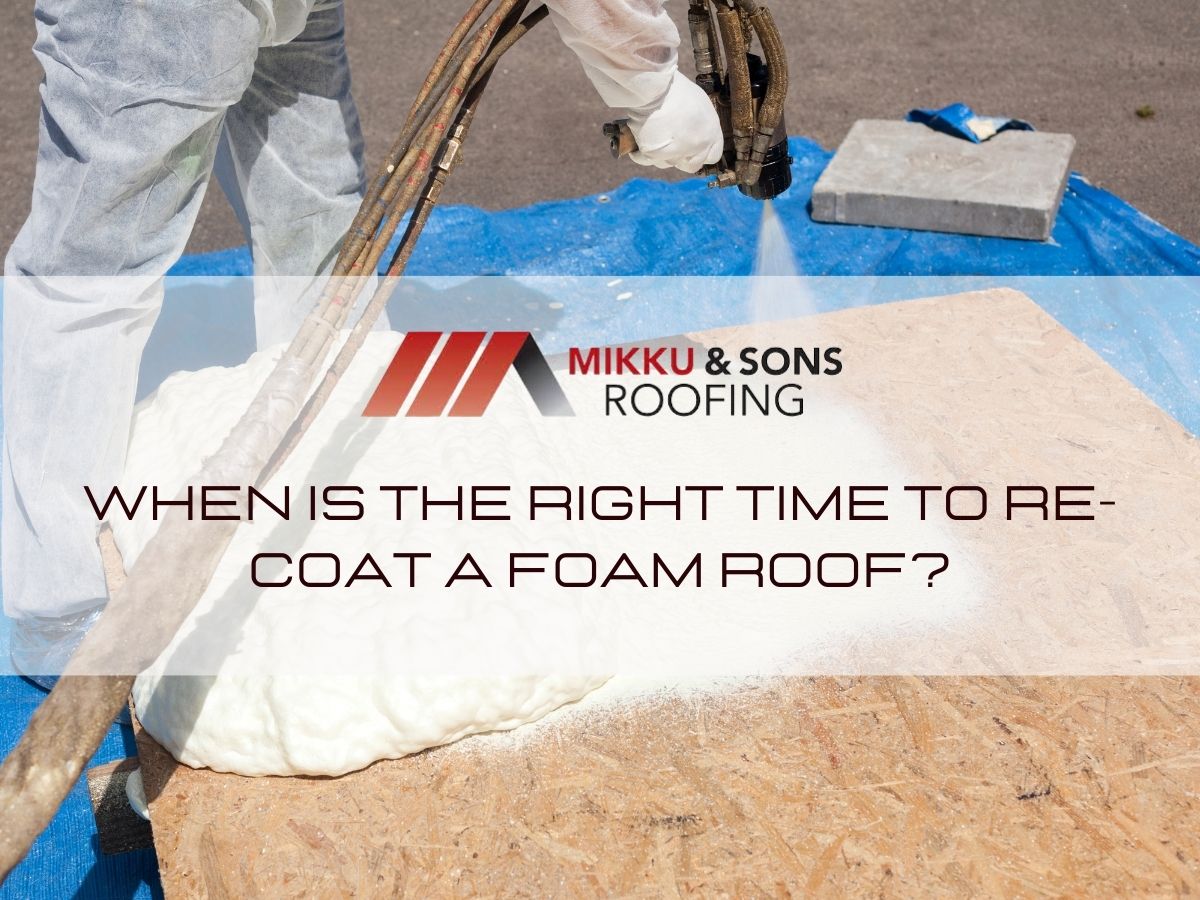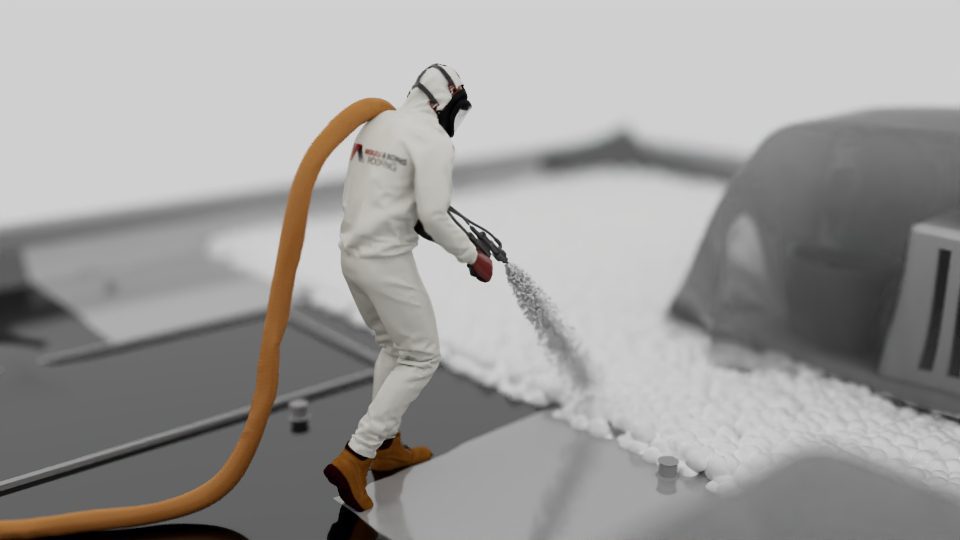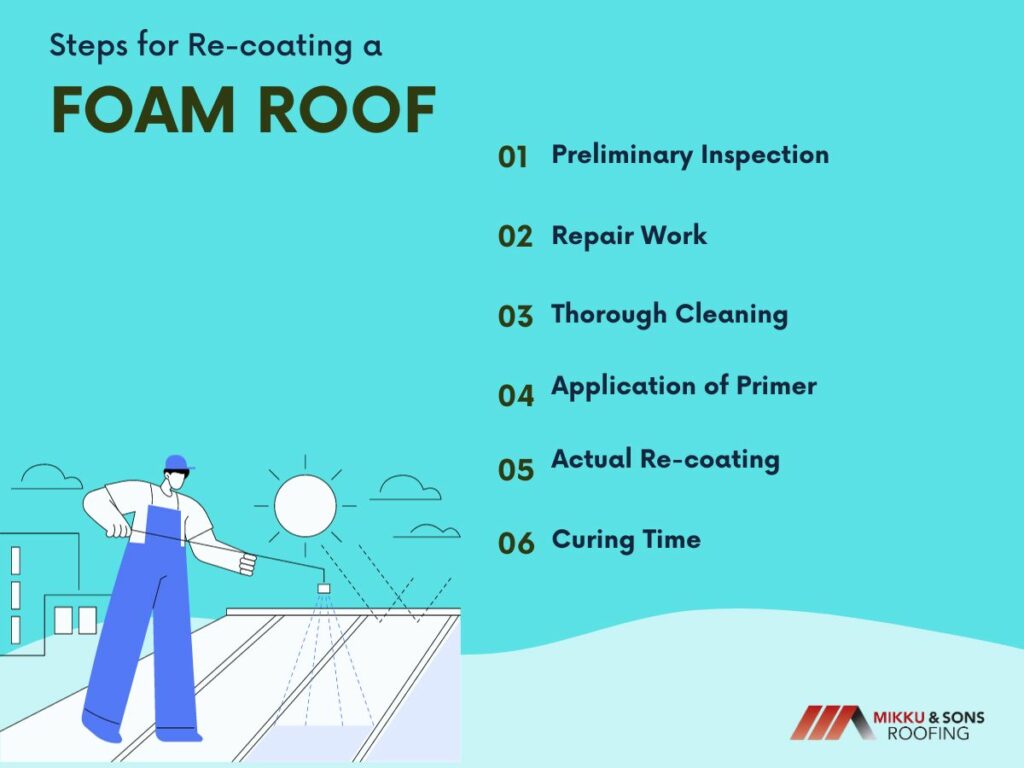

The importance of a robust and durable roof cannot be overstated. So, when is the right time to re-coat a foam roof?
Foam roofing, composed primarily of polyurethane foam, has proven to be a dependable choice for many property owners due to its insulation proficiency, water resistance, and longevity. Even with these merits, ensuring timely maintenance, particularly the recoating of a foam roof, is pivotal to maximizing its lifespan and efficacy.
This detailed article explores the critical considerations and guidelines for determining the optimal time for recoating a foam roof, offering insights into the signs, seasonal preferences, and step-by-step procedures involved in the re-coating process.

A foam roof, characterized by its insulation capabilities and durable nature, is an asset to any building. However, understanding the significance of timely re-coating is crucial to sustain its performance and extend its lifespan.
Re-coating a foam roof is applying a new coating layer over an existing foam roof. This is done to protect the foam from the elements and to extend its lifespan. Foam roofs are typically re-coated every 5-10 years, depending on the type of coating and the climate.
The re-coating process typically involves cleaning and inspecting the roof, applying a base coat, and then applying a top coat. There are various coatings that can be used to re-coat a foam roof, and the best coating for your roof will depend on the climate, the type of foam, and your budget.
Re-coating is an indispensable aspect of foam roof maintenance, enhancing the roof's resilience against various environmental and mechanical stressors, including UV radiation, rainfall, wind, and physical impacts.
Here are some of the benefits of re-coating a foam roof:
A consistent recoating schedule effectively preserves the foam roof's structural integrity, thereby prolonging its service life.
Determining the right time to re-coat a foam roof is a strategic decision that hinges on various factors, ranging from the visible condition of the roof to its age and the external environmental factors to which it is exposed.
Here's an in-depth exploration into the various considerations and indicators that can guide property owners in making an informed decision about the right time for re-coating their foam roof.

One primary factor in determining the need for re-coating is the age of the foam roof. Typically, a re-coating is recommended every 5 to 10 years, though this timeline may vary based on the specific materials used and the climate in the area. Keeping track of the last time the roof was coated is essential for timely maintenance.
Visible signs of damage or wear on the foam roof, such as cracks, blisters, or a rough texture, indicate the need for re-coating. Prompt attention to these issues prevents further deterioration and ensures the continued effectiveness of the roofing system.
The appearance of water ponds or leaks on the foam roof suggests a decline in its water-resistance capabilities. Re-coating at this juncture is crucial to restore its waterproof properties, thereby preventing additional water damage to both the roof and the underlying structure.
Fading or chalking of the roof surface indicates the breakdown of the existing coating under UV exposure. This sign signifies that it’s time to apply a new coating to protect the foam substrate from UV damage and maintain the roof’s energy efficiency.
Weather plays a significant role in determining the right time for re-coating. Ideal re-coating should be undertaken in mild, dry weather conditions, preferably when temperatures are consistently between 50°F (10°C) and 100°F (37.8°C). This range allows for optimal adhesion and curing of the new coating.
The rainy season is unsuitable for re-coating due to moisture, which can negatively impact the adhesion of the new coating. Similarly, freezing conditions can affect the curing process and the performance of the coating. Planning the re-coating project outside these seasons is advisable.

A professional inspection can provide a thorough and accurate assessment of the foam roof’s condition, helping make an informed decision about the timing for re-coating.
Roofing experts can identify issues or potential problems that may not be apparent to the untrained eye, ensuring that the re-coating is performed at the optimum time to maximize its benefits.
Engaging professional services for inspection and assessment adds an extra layer of assurance, ensuring that the re-coating process is timely and effective, and contributes to the prolonged life and performance of the foam roof.
Re-coating a foam roof is a meticulous process that involves several crucial steps to ensure the effectiveness and longevity of the new coating. A structured approach, incorporating a thorough inspection, repair, cleaning, and correct application of the new coat, guarantees optimal results.
Below is a comprehensive guide outlining the successive steps involved in re-coating a foam roof.

Initiate the recoating task with a comprehensive inspection of your foam roof. Assess its current condition, identifying and documenting areas requiring repairs or special attention. Engaging a professional roofing contractor for this evaluation can provide expert insights and recommendations.
Prioritize addressing any discernible damage, including cracks, blisters, or areas of foam exposure. Effective repair work ensures a solid foundation for the new coating, guaranteeing optimum adhesion and protective coverage.
A clean surface is crucial for the new coating’s successful application. Employ appropriate cleaning techniques, possibly utilizing a power washer, to meticulously remove accumulated dirt, debris, and loose materials from the roof surface.
Apply a suitable primer to the cleaned and repaired roof surface. A primer enhances the new coating’s adhesion, ensuring a secure and long-lasting bond with the foam roof surface.
With the roof surface primed, proceed with applying the new coating. Adhere to the manufacturer’s guidelines, ensuring you achieve uniform coverage and the recommended coating thickness for maximum protection and durability.
Post-application, allow ample time for the new coating to cure fully. Refrain from any activity on the roof during this period to avoid compromising the coating’s integrity.
Understanding the appropriate timing and processes for recoating a foam roof is imperative for maintaining its durability and functional reliability. Heeding the highlighted signs, opting for suitable weather conditions, and following the detailed recoating steps ensure your foam roof remains in peak condition, providing dependable protection for your building for years.
Hiring experienced and skilled professionals for the recoating project can further guarantee exceptional workmanship and results, warranting your investment's optimum value and your building's sustained safeguarding.
